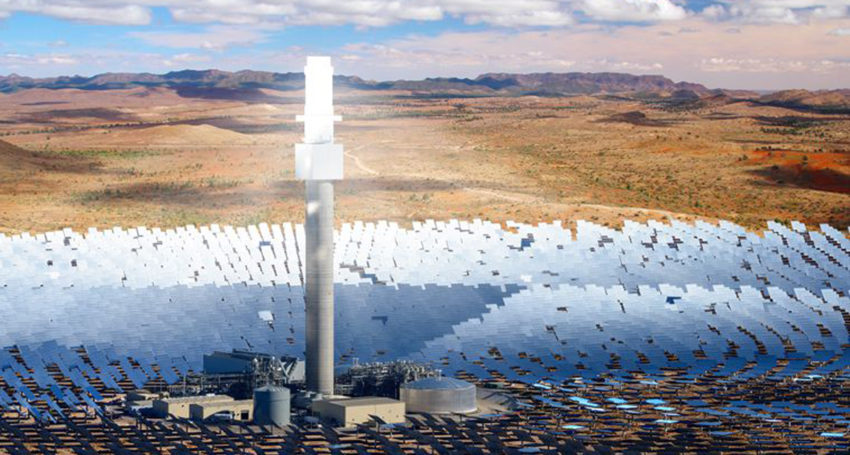The $650 million Aurora solar thermal plant has been abandoned by SolarReserve after it ran into difficulties in securing finance for the project. The South Australian government now readies to put out a new tender for a long-term electricity supply contract.
The government was informed by the U.S. company that it would not be in position to achieve financial close by the end of next month. The company had until May 31, 2019 to obtain the necessary finance for the CSP project, after the original deadline – February 1, 2018 – was generously extended.
SA Energy Minister Dan van Holst Pellekaan confirmed he received the information from SolarReserve on Thursday, which proposed to sell the project to a third party who may take the 165 MW plant or an alternative project forward at the site.
The state government said it will immediately begin the process of returning to market to secure its future electricity needs, noting that any party that might purchase the project from SolarReserve will be able to tender for the new contract.
The project was expected to cover 100% of the SA government’s power needs, under a 20-year generation project agreement inked in 2017. SolarReserve’s bid at the time of $78/MWh was unexpectedly low for CSP, and went on to win the government tender.
Prior to that, the former Labor state government approved $110 million in the form of a concessional equity loan to back the project with an eye on putting downward pressure on electricity prices, thus making it possible for SolarReserve to offer the lowest-cost option in the tendering process.
The Aurora plant was granted a development approval by the South Australian government in January 2018, paving the way for construction to begin the same year.
Positive signals arrived in September when SolarReserve moved on to ink a memorandum of understanding with local outfit Heliostat SA to supply its heliostats and heliostat components to the project. The production of heliostats was forecast to create close to 200 jobs in South Australia, including over 115 skilled labor positions related to manufacturing of steel components and heliostat assemblies.
Overall, the Aurora project was anticipated to create an additional 650 full-time construction jobs on site, and more than 4,000 direct, indirect and induced jobs in the region.
The jobs as well as new generation capacity are more than welcome in the region which saw the closure of its Northern coal power station in 2016. Community group Repower Port Augusta said it was devastating news that SolarReserve pulled out of building the CSP plant.
“This project is too big to fail,” the group said in a statement. “For our local community whose hopes for the future were tied up in this job creating project going ahead and for the South Australian and Federal Governments who risk a major backlash if this project is not built.”
Presently, the SA government’s energy need are supplied by Simec Zen Energy, under a bridging contract until November 2020 with an extension option if required.
“Both the current and former State Government modified and extended the terms of the contract to assist SolarReserve to meet its commitments under the agreement,” van Holst Pellekaan said, noting that the company first notified the previous state government of their difficulties in securing finance, and they were granted additional time.
Similar to SolarReserve’s landmark project in the Nevada desert, the 110 MW Crescent Dunes facility, the Aurora project would incorporate heliostats, special mirrors, to concentrate sunlight onto a tower that heats molten salt to create steam and power a turbine. It would incorporate an eight-hour full load storage, enabling on-demand energy production day and night.
The plant would be designed with the option to add solar PV technology in order to maximize electricity generation from the CSP facility during peak demand periods, as well as meet the station’s own electricity needs.
Last September, SolarReserve said the Aurora project was part of a much bigger picture for SA. The firm announced plans to build six solar thermal projects in the state over the next ten years, with its Australian headquarters in Adelaide serving as the development hub and South Australian manufacturing well-positioned to support these future projects.
Further comment from SolarReserve had not been provided by the time this article was published.
This content is protected by copyright and may not be reused. If you want to cooperate with us and would like to reuse some of our content, please contact: editors@pv-magazine.com.









By submitting this form you agree to pv magazine using your data for the purposes of publishing your comment.
Your personal data will only be disclosed or otherwise transmitted to third parties for the purposes of spam filtering or if this is necessary for technical maintenance of the website. Any other transfer to third parties will not take place unless this is justified on the basis of applicable data protection regulations or if pv magazine is legally obliged to do so.
You may revoke this consent at any time with effect for the future, in which case your personal data will be deleted immediately. Otherwise, your data will be deleted if pv magazine has processed your request or the purpose of data storage is fulfilled.
Further information on data privacy can be found in our Data Protection Policy.